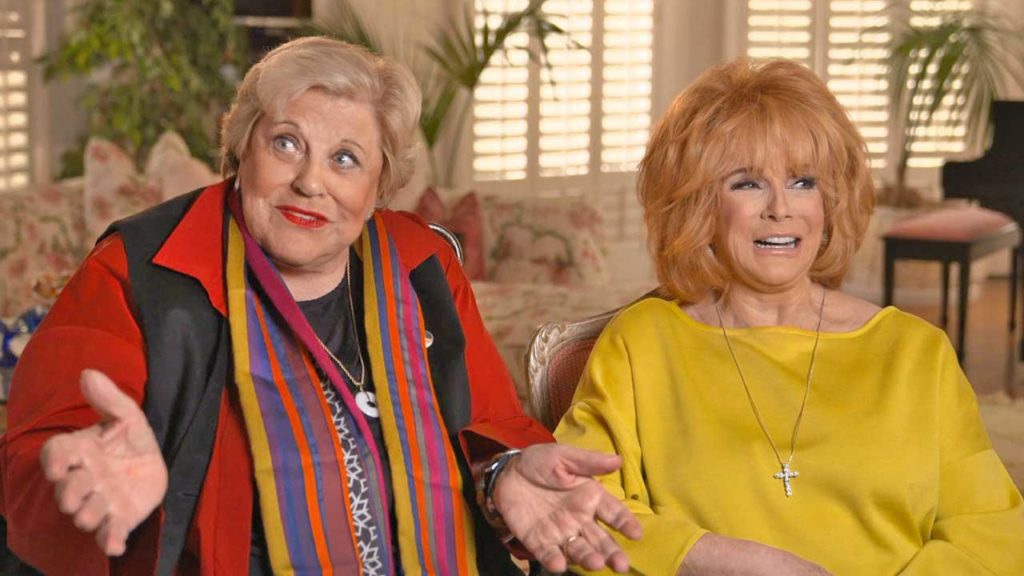Before she died last year at age 93, the legendary Kaye Ballard was interviewed for the documentary, “Kaye Ballard — The Show Goes On!” The film, directed by Dan Wingate, and available on demand starting July 17, is a valentine to the musical comedy performer. Ballard recounts her life and career through an extended interview, chock-full of clips of her performing on stage, screen, and in TV appearances. She is a fabulous raconteur, and her anecdotes are often quite funny — especially one about Lenny Bruce and a check he received for a song he wrote for her.
The documentary’s tone is deliberately affectionate. It celebrates a performer who was always wonderful, but never quite got her due. Ballard was never nominated for a Tony award, despite rave reviews for her work in “The Golden Apple” and “Carnival” on Broadway, and she never had her name above the title in any of her film roles. She worked for decades in variety shows and TV series but even when she headlined “The Mothers-in-Law,” it was cancelled after two seasons.

“Kaye Ballard — The Show Goes On!” will make fans wish Ballard had been a bigger star. She worked with a who’s who of talent, including Woody Allen, Jerry Stiller, Ann-Margaret, Carol Burnett, Carol Channing, and Donna McKechnie — all of whom are interviewed in the film. She met Andy Warhol and went to his factory, received letters from Jodie Foster after working together in “Freaky Friday,” and she knew George Clooney would be famous before he did.
A fan of “The Wizard of Oz,” Ballard performed separately with Bert Lahr and Ray Bolger, and did a dead-on impression of Judy Garland. Hal Prince claims in the film that Ballard had a voice “as good as Garland’s,” and it is heard throughout the documentary proving his point that she has “a huge set of pipes” and “impeccable delivery.”
Moreover, out gay musician and archivist Michael Feinstein recounts a story of John Kander and Fred Ebb giving Ballard the song “Maybe This Time,” after Ballard graciously passed their tune “My Coloring Book” to Sandy Stewart, and it became a huge hit. While Ballard debuted “Maybe This Time,” the song is most known from Liza Minelli’s rendition of it in the film version of “Cabaret.”

The film recounts other “near misses” in Ballard’s career. She gives a knockout performance as Mama Rose in “Gypsy” in a TV appearance, but she never got to play that role on Broadway. Likewise, while her efforts to get a Fanny Brice project off the ground prevailed, it gave Barbra Streisand a career-defining role.
“Kaye Ballard — The Show Goes On!” illustrates Ballard’s incredible instincts and versatility. She could do comedy, sing and even play the flute, as she did with Henry Mancini and Miss Piggy (in separate appearances). She was a master at impressions and did Bette Davis on “To Tell the Truth,” but had a friendly conflict with “Hollywood Squares” host Peter Marshall because she was unable to lie.
It is amusing, and slightly discouraging to think that in her later career Ballard was known mainly for being a “screaming Italian,” given her work on “The Mothers-in-Law” and on “The Doris Day Show.” She also appeared as a high strung Italian in the film version of the late gay playwright Terrence McNally’s “The Ritz.” Ballard reflects on these moments with candor and cheer, explaining how wonderful it was to work with co-stars Eve Arden and Doris Day, or make the film with Treat Williams, Jack Weston, and Rita Moreno. The film provides a nostalgic trip down memory lane for Ballard. She is engaging, similar to a favorite great aunt recounting family history.
Ballard only briefly touches on sore subjects. She is saddened to recall that Danny Fortus, her costar in two short-lived musicals, “Minnie’s Boys,” and “Molly,” died of AIDS. She also acknowledges that she did not have the best relationship with her mother, who never understood her work. Ballard’s personal life is never discussed, which may have been a deliberate decision. She hints at come-ons from various men, all of which she turned down.
The best segments in the film feature Ballard recounting her early years, from first attending a Broadway show to her friendship with Marlon Brando, who took her to Fire Island.
She also effuses about appearing in Stephen Sondheim’s “Follies” and the review “4 Girls 4” late in her career.
Overall, Ballard comes across as a survivor. When discussing an unhappy collaboration with Phil Silvers, she explains, “When someone gets me down, it makes me stronger.” Her fortitude is what is on display throughout “Kaye Ballard — The Show Goes On!” and it explains why she thrives even as greater success eluded her. This worthwhile documentary is a terrific tribute to her life and accomplishments.
